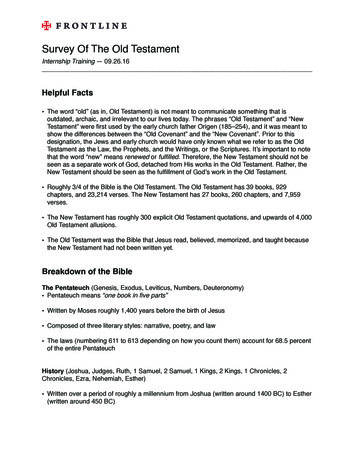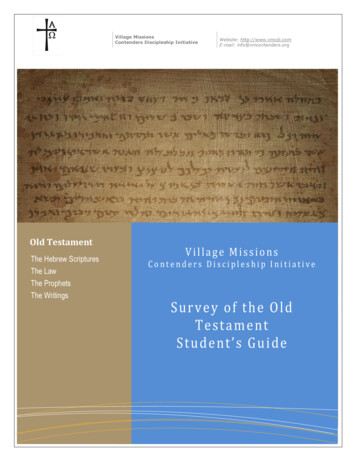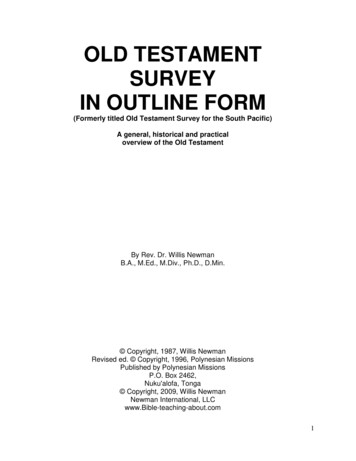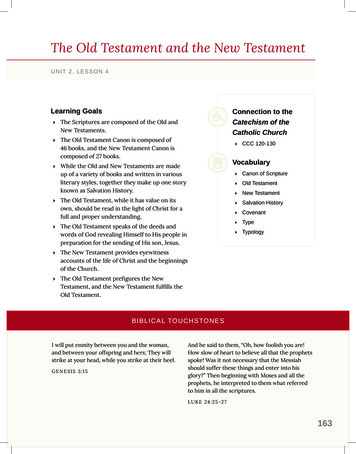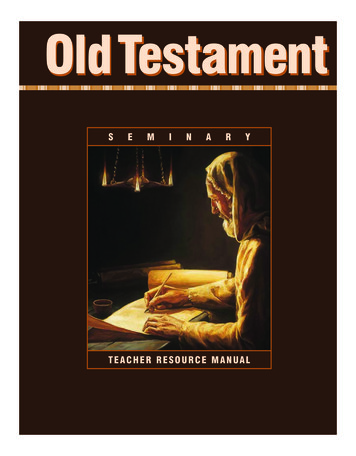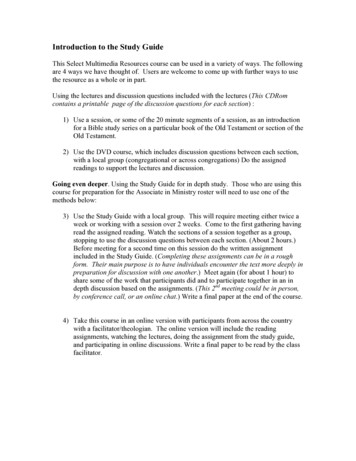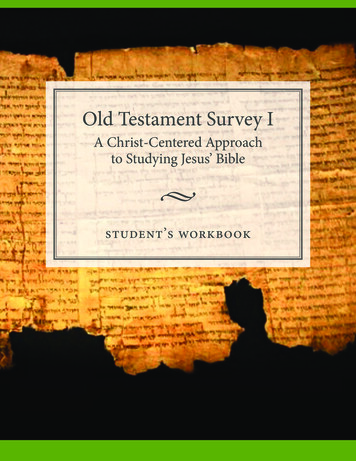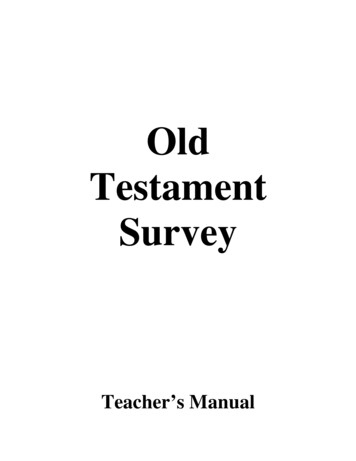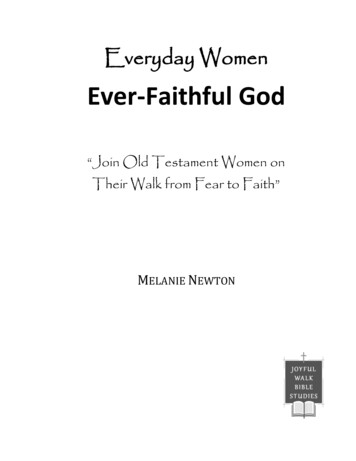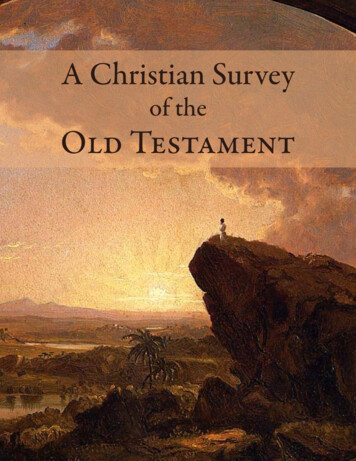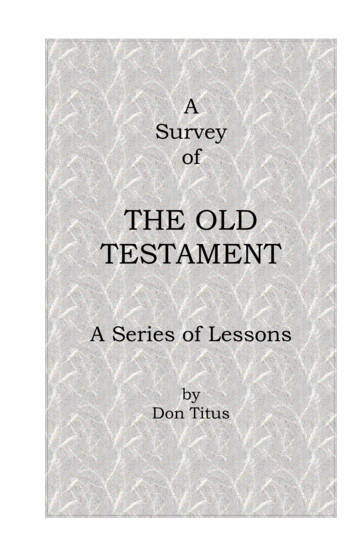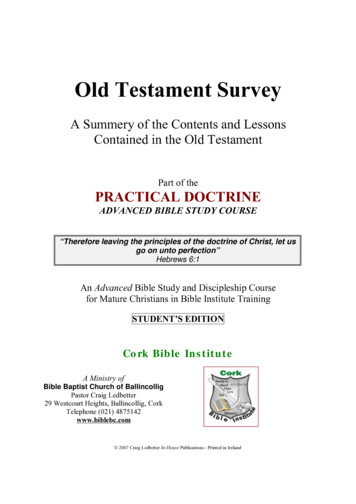
Transcription
Old Testament SurveyA Summery of the Contents and LessonsContained in the Old TestamentPart of thePRACTICAL DOCTRINEADVANCED BIBLE STUDY COURSE“Therefore leaving the principles of the doctrine of Christ, let usgo on unto perfection”Hebrews 6:1An Advanced Bible Study and Discipleship Coursefor Mature Christians in Bible Institute TrainingSTUDENT’S EDITIONCork Bible InstituteA Ministry ofBible Baptist Church of BallincolligPastor Craig Ledbetter29 Westcourt Heights, Ballincollig, CorkTelephone (021) 4875142www.biblebc.com 2007 Craig Ledbetter In-House Publications - Printed in Ireland
Old Testament SurveyClass RequirementsTable of ContentsPRACTICAL DOCTRINE 1Class Requirements 4Preliminary Bible Information 5Brief Bible History Timeline to the Time of the Messiah 12Outline of The Old Testament 13Key People of the Old Testament 14Outline of The Old Testament 16Key People of the Old Testament 18The Doctrinal Fundamentals Taught in the first Twelve Chapters of Genesis 19General Outline of Genesis 20A Chapter by Chapter Outline of the Events of Genesis 22Study Questions For Genesis 23Exodus Through Deuteronomy 24Exodus 25Leviticus 28The Book of Numbers 30Deuteronomy 32Study Questions for Exodus Through Deuteronomy 34Joshua, Judges, Ruth 35The Book of Joshua 35Judges 37Ruth 39Section Quiz 1 401&2 Samuel, 1&2 Kings 411 Samuel 412 Samuel 431 Kings 462 Kings 491&2 Chronicles, Ezra, Nehemiah 521 Chronicles 522 Chronicles 54Ezra 57Nehemiah 59Esther 61Section Quiz 2 64CBI - Practical DoctrinePage 2
Old Testament SurveyClass RequirementsJob, Psalms, Proverbs 65Job 65Psalms 70Proverbs 72Ecclesiastes, Song of Solomon 74Ecclesiastes 74Song of Solomon 77Section Quiz 3 79Isaiah, Jeremiah, Lamentations 80Isaiah 80Jeremiah 84Lamentations 86Ezekiel, Daniel 87Ezekiel 87Daniel 89Section Quiz 4 90Hosea, Joel, Amos, Obadiah, Jonah 91Hosea 91Joel 93Amos 94Obadiah 95Jonah 96Micah thru Malachi 97Micah 97Nahum 98Habakkuk 99Zephaniah 100Haggai 101Zechariah 102Malachi 103Section Quiz 5 104Christ in the Old Testament 105Old Testament Survey Final Exam 107CBI - Practical DoctrinePage 3
Old Testament SurveyClass RequirementsClass RequirementsRequirements To Complete This Class:1.2.3.4.5.Keep these notes in an A4 binder.Fill in the blanks in these notes.Take notes during class.Look up and read all the verses in the material as you read through the material.T-H-I-N-K as you read this material. It will be a blessing to you, and it will alsochange your life.6. Take all the Pop-Quizzes, and have a passing average score of 70%7. Take the Final Exam, and make at least 70%8. Complete the Class ProjectYour overall score for the class will consist of the following components:25%25%25%25%Quality of notes takenAverage Pop-Quiz scoresClass ProjectFinal ExamThis class will be recorded, so the sessions will be available for listening to via CD’s, but they willcost 3 each.Suggested books for your personal Library include:Wilmington’s Guide to the BibleHalley’s or Unger’s Bible HandbookStudy of Genesis, by Pastor Craig LedbetterStudy of the Covenants, by Pastor Craig LedbetterStudy of Dispensations, by Pastor Craig LedbetterClass Project assigned for this course (worth 25% of your grade):Summarize one of the following books in the Bible. You will have to write a two page paper,single spaced, describing the author, the time of writing, and the general list of events coveredin the Book.You can summarize one of the following Books: Ruth, Esther, Nehemiah, or 1 SamuelCBI - Practical DoctrinePage 4
Old Testament SurveyPreliminary Bible InformationPreliminary Bible InformationI. The Bible as a WholeA. Our Bible consists of a collection books.B. These are divided into groups of books1. The Old Covenant scriptures and the New Covenant scriptures; or, as we commonly namethem, the Old and New Testaments.2. Each of these two Testaments are not in historical order, but have been laid-out accordingto content. In other words, the books of the Bible are grouped along with other books thatspeak of the same thing.C. The Bible is the most published book in the world of all time.D. It is the word of God for the heart of man. It alone has changed the ways of mans thinking andactions like nothing else.E. Therefore it will be the most hated object in the universe by Satan!II. The Old TestamentA. The First Books - Genesis, Exodus, Leviticus, Numbers and Deuteronomy.1. These are called, The Pentateuch, or Toraha. Pentateuch means " "b. Torah means " " or "teaching."2. Who wrote the Pentateuch?a. The Lord commanded to write down various things; “in a book” (Ex17:14); “write these words” (Ex 34:27)b. Exodus says that “ wrote all the words of the Lord” (Ex 24:4); he wrote theitinerary of the exodus wanderings (Num 33:2); “Moses wrote this law” (Dt 31:9). InExodus 24:7 it is said that Moses read the book of the covenant, which he must havejust completed.c. The rest of the OT bears witness to the writing of the Pentateuch by Moses. Davidreferred to “the law of Moses” (1 Kgs 2:3). In the time of Josiah there was found inthe temple the “book of the law of the Lord given through Moses” (2 Chr 34:14). Dayby day Ezra read from “the book of the law of God” (Neh 8:18; cf. “the book of thelaw of Moses,” 8:1).d. In the NT, Jesus refers to “the book of Moses” (Mk 12:26; Lk 20:37) and otherwisementions the commands or statements of Moses (Mt 8:4; 19:8; Mk 7:10; cf. Lk 16:31;24:44). The Jews also quoted from the Torah as coming from Moses, and Jesus didnot contradict them.3. What’s The first Five Books All About?a. Genesis deals with the fall of man and God's selection of His people, the Jews, to bethe channel for His great plan of redemption.b. The rest of the Pentateuch deals with Israel's deliverance from Egypt (first half ofExodus) and detailed explanation of God's Law:1) The law (no longer applicable for today)2) the law (still relevant for today for loving God and your neighbour).3) The law (rules for how human are to govern themselves)c. They are loaded with important principles for living.B. The Historical Books: Joshua to Ezra.CBI - Practical DoctrinePage 5
Old Testament SurveyPreliminary Bible Information1. These books deal with Israel's conquest of the Promised Land and their general failure tofulfill their covenant obligations to God.2. Their disobedience ultimately brings God's judgment as He disperses Israel (721 BC.) andallows Judah to be taken into the Babylonian captivity for 70 years (586 BC.).C. The Poetic Books: Job, Psalms, Proverbs, Ecclesiastes, Song of Solomon, Lamentations.1.2.3.4.5.6.7.These books deal with a variety of life's issues.Psalms is a book of prayer and praise toward God.Proverbs deals with how to live life .Job deals with the problem of and Ecclesiastes deals with the problem of pleasure.Song of Solomon is a portrayal of married love.Lamentations features Jeremiah's laments over the fall of Jerusalem.Don’t take the name “poetic” to mean not as valuable or literal as the other parts of theBible! It just means they were written more for the heart!D. The Four Major Prophets: Isaiah, Jeremiah, Ezekiel, and Daniel.1. These books focus on the sins of God's people, God's judgment, and the future promisesof the New Covenant through the redemptive work of Jesus Christ.E. The Twelve Minor Prophets: Hosea through Malachi.1. These books also denounces the sins of God's people, the means of God's judgment, andgives ultimate hope through prophecies of Christ's coming and redemptive work.III. The Canon of Scripture – How We Know the Bible is CompleteA. Definition1. Canon - KANON (Greek) - a measuring rule or .2. The term Canon of scripture means the complete collection of books which are regardedas of Divine authority. The word canon in Greek means a straight rod, rule, or measure.As applied to Scripture it means the rules by which certain books were declared to beinspired and accepted as such.B. Why do we need a canon of Scripture?1.2.3.4.C. Criteria For Old Testament Canonicity1. The doctrine of (2 Peter 1:21; 2Tim 3:16)2. evidence (Deuteronomy 31:24-26, Joshua 1:8, Judges 3:4).3. Proven by - New Testament quotes by Jesus Christ and others declare theOld Testament to be the Word of God, e.g. (Matthew 22:29, John 5:39, John 10:35).Many N.T. scriptures prove that the present Canon of Scripture of the O.T. was acceptedin the days of Christ and the apostles (Mt. 21:42; 22:29; 23: 33; Lk. 11:51; 24:27 -32, 44;In. 5:39; 10:35; 2 Tim. 3:15-17).4. The Number Of Old Testament Books was “ ” in the Hebrew Cannon, 39 in EnglishCBI - Practical DoctrinePage 6
Old Testament SurveyPreliminary Bible Information5. The Apocryphal books - In some Bibles there is a section of up to 14 books called theApocrypha- a group of spurious books that were rejected from our present canon ofScripture because they did not pass the tests required of inspired books:a. These books are included in the apocrypha: 1 & 2 Esdras, Tobit, Judith, additions toEsther, The wisdom of Solomon, Ecclesiasticus, Baruch , The letter of Jeremiah, Theprayer of Azariah, Susanna, Bel and the Dragon, The prayer of Manassah, 1 & 2Maccabeesb. They were not written or approved by a proven prophet of Godc. They were not recognized by the Jews, as inspired and a part of Scriptured. They were not recognized or quoted by Christ and the apostles, a fact that is morestriking when we realize that Paul even quoted twice from heathen poetse. The last O.T. prophet predicted that the next messenger coming to Israel from Godwould be the forerunner of Christ (Mal. 3:1). Most of the Apocryphal books werewritten during the period between Malachi and Christf. Divine authority is not claimed by their authors, and by some it is virtually disowned(2 Macc 2:23; 15:38)g. The books contain statements in conflict with the Bible’s historyh. They are self -contradictory and, in some cases, clearly contradict the doctrines ofScripturei. Josephus, who lived at the time of the apostles, did not regard the Apocryphal booksas Scripture. He stated that the O.T. books (the ones in our present version) were theonly inspired writings (see Josephus, Book I, section 8)j. The Apocryphal books were not a part of the ancient versions of Scripture.1) They were first added after 300 A. D.2) The Laodicean Council in 363 A. D. rejected them as being uninspired, thusproving that by that time some were claiming inspiration for them.3) They first appeared in the Vatican Version of the 4th century. At the Council ofTrent in 1546 A. D. Catholics accepted 6 of these books as inspired and addedthem to their modern versions of Scripture. They are: Wisdom of Solomon,Ecclesiasticus, Tobit, Judith, 1 and 2 Maccabeesk. Philo and others did not regard the Apocryphal books as inspiredl. There is a lack of prophetic element in them; and there is an apparent imitation of theinspired O.T. booksD. Inspiration of the Bible1. The creation of the Canon of Scripture was gradual and not created by any ecclesiasticalauthority.a. The beginning books were written by Moses (Ex. 17:14), and then by Joshua, etc.b. In David's time the office of recorder was established and detailed records were keptby all the official recorders of the kings of Israel.c. The final collection of writings and the Canon of the O.T. was completed during thetime of Ezra, Nehemiah (Ezra 7:6; 8:1-8).d. After the destruction of Jerusalem in 70 A.D., the Sanhedrin moved to Tiberius andlater to Jammia, a small town 13 mi. south of Joppa where, in 90 A.D. the Canon ofthe O.T. was again decided upon, the apocryphal books (most of which were writtenthe last 3 centuries B. C.) being rejected from the Jewish Canon of Scripture.e. This list of O.T. books called the Palestinian Canon has been universally accepted bythe Bible-Believing and Protestant ChurchE. The Bible a Revelation1. Christianity is a revealed religion, the record being contained in the sacred Scriptures.Much of the Bible is a revelation. Man could never have known about ages of the eternalCBI - Practical DoctrinePage 7
Old Testament SurveyPreliminary Bible Informationpast, Lucifer's past, the creation of the spirit and material worlds, the future eternal ages,and many other things related to God's plan for man except by direct revelation of thesethings through the Holy Spirit (Rom. 16:25; Eph. 3:3; Col. 1:26; 2:3; Rev. 1:1). The manyhundreds of prophecies are a direct revelation of things to come, which God alone couldgive (Acts 15:18;Eph. 2:7; 3:9-10; Rev. 1:1)2. The ignorance of man regarding his origin, past, and eternal future; his lack of knowledgeconcerning the will of God; and the fact that all philosophers have failed to construct acomplete coherent, and adequate religion these things make revelation absolutelynecessaryF. Genuineness and Authenticity of the Bible1. By genuineness we mean that the books of the Bible were actually written by the menwhose names they bear, or that there is sufficient proof of their authorship, and that theywere written at the time claimed2. Authenticity means that the Bible relates truthfully the matters it deals with, and thecontents are authentic and reflect the word of God as originally written3. 6 proofs Bible genuine and authentic:a. Claims of the Bible itself:1) The prophets of the O.T. claimed they were sent of God and that their messageswere given to them by God (Lk. 1:70; Acts 3:31; 2 Pet. 1:21). Over 2,500 timesthe prophets claimed that God spoke by them (Isa. 8:5; Jer. 2:2; Ezek. 2:4; etc.)2) The whole Bible centres around the person and work of Jesus Christ. In the O.T.we have hundreds of predictions concerning Him, and in the N.T. we have thefulfilment and continuation of His life and ministry. He, Himself claimed to havebeen sent by God (In. 8:42; 7:16; 17:8). He performed miracles to confirm Hismission (Acts 10:38); what He foretold came to pass and will yet come to pass.He put His seal upon the genuineness and authenticity of the O.T. (Mt. 5:17-18;8:17; 12:40 - 42; Lk. 24:44; Jn. 5:39)3) The Bible also represents the commission of the apostles as divine. Godconfirmed their ministry by signs and wonders (Mk. 16:15-20;Acts 2:41-46; 5: 115; Heb. 2:1-4).In all their writings they confirmed the teachings of Christ; andtheir declaration thereof was by supernatural powers4) The testimony of the N.T. to the genuineness and authenticity of the O.T. is plainto see. The O.T. is quoted about 250 times in the N. T., and alluded to about 850times. All O. T . books are either quoted or alluded to except Esther, Ezra,Nehemiah, Ecclesiastes, and the Song of Solomon 2 Testimony of secular historyb. The events of Bible history were well known among all nations. Happenings of the N.T., having come to the knowledge of the then known world, were referred to byvarious secular authors of the first 4 centuries of the Christian era. Jerome, in 392 A.D., mentioned about 50 other authors as making quotations about and referring toN.T. events. They belonged to all parts of the world, but they agreed on one thing thatthe Jewish scriptures were genuine and authentic, referring to them as a distinctvolume universally received as such. No event in ancient history can produce morethan a fraction of the evidence by which the Bible in its entirety is sustained asgenuine and authenticc. Ancient manuscripts. No original MS. can be produced due to the perishable materialwritten on, such as paper and vellum (skins of animals). However, because of the dryclimate of Egypt and Palestine, many thousands of copies-whole books or partsthereof, have been preserved for us. It is not necessary to produce origina1 MSS. toprove the genuineness and authenticity of the Bible any more than it would benecessary to produce the original Declaration of Independence to prove the manycopies we have contain the statements of the original. Scholars are willing to admitthe genuineness and authenticity of other writings if there are as many as 10 copies ofCBI - Practical DoctrinePage 8
Old Testament SurveyPreliminary Bible Informationthe originals to be found. On this basis the Bible can be proved genuine and authenticthousands of times Number of manuscripts:1) Uncial manuscripts. All letters of uncial copies are 1 inch high; they are the oldestMSS. before the 9th century A. D.a)b)c)d)e)GospelsActs; general epistlesPauline epistlesApocalypse (Revelation)Total.101222791562) Cursive manuscripts. Cursive copies are those in running hand-writing asintroduced about the 9th century A. D., and used in Bible making up to theinvention of the printing press, 1456 A. D.a)b)c)d)e)GospelsActs; general epistlesPauline epistlesApocalypse (Revelation)Total1, 4204505201952, 5853) Since the catalogue of these MSS. Was made there have been many newdiscoveries of whole books and portions of the Bible-the Dead Sea scrolls ofIsaiah and other ancient writings, for instance. Some Bible texts have been foundwhich are at least 100 -200 years earlier than the above. Besides these GreekMSS. there are many in Syriac, Coptic, Latin, and other languages, of bothtestaments, some dating back to the 3rd century, B. C. In 1897 literally tons ofpapyri were found in the Nile valley about 120 mi. south of Cairo, thousands ofpieces being written in the language of the N.T. In another discovery there wereat least 1,000, 000 papyri; and of these many thousands have. never been edited.Other collections have also been located, some dating back to 100 -600 A. D.,and new discoveries are being made all the time. A recent report says that thereare about 5,000 Greek MSS. of the N.T. in all, and from 20,000 to 30, 000 inother languages besides 100, 000 to 200, 000 quotations in the writings of theearly church fathers. See point 5, below4) Some Uncial manuscriptsa) Sinaiticus or Codex Aleph, dating back to the 4th century. It was discoveredby Dr. Tischendorf in the St. Catherine convent on Mt. Sinai in 1859. Itcontains the whole Bible adding also the Epistle of Barnabas and theShepherd of Hermas, in partb) Alexandrinus or Codex A, dating back to the 5th century. It contains thewhole Bible parts of Genesis, 1 Kings, Psalms, Matthew, John, and 2Corinthiansc) Vaticanus or Codex B, dating back to the 4th century. It contains almost all ofO. T., and the N.T. down to Heb. 9:14d) Ephraem or Codex C, dating back to the century. It contains part of the O.T.and all the N.T. books except 2 Thessalonians and 2 Johne) Bezae or Codex D, dating back to the 6th century .It is written in Greek andLatin in parallel columns and contains most of the gospels, Acts, and theepistlesf) Claromontanus or Codex D, also in Greek and Latin like the Codex Bezae,and dating back to the 6th century. It contains most all the epistles Besidesthese there are many more dating back from the 6th to the 10th centurieswhich space will not permit the listing of.CBI - Practical DoctrinePage 9
Old Testament SurveyPreliminary Bible Informationd. Lectionaries - These are collections of the gospels and epistles for reading inchurches, some dating back from, the 7th to the 10th centuries. They help indetermining the exact text. Of these there are more than 1, 000 of the gospels and 300of the Acts and epistlese. Patristic quotations - These are quotations of the Bible by early Christian writersthose of the first 3 centuries. They help in determining the exact text, filling the gapbetween the time of the apostles and the earliest MSS. of the 4th century. If the N.T.were destroyed it could be practically reproduced from these quotations of the earlyfathers alone. See The Ante-Nicene Fathersf. Ancient versions - The many ancient versions of Scripture in many languages, datingfrom the 2nd century to the 12th century A. D. add much to the proof of thegenuineness and authenticity of the Bible.1) Septuagint in Greek, 2nd or 3rd century A.D.2) Persian version, 2nd century A .D.3) Samaritan Pentateuch, 1st or 2nd century A. D.4) Version of Aquila. Greek of the O.T. about 160 A. D.5) Version of Theodotian, O.T. in Greek, 2nd century A. D.6) Version of Symachus, O.T. in Greek, 2nd century A. D.7) Peshitta Syriac version, 2nd century A. D. .8) Armenian version, 5th century A. D.9) Egyptian version, 4th century A. D.10) Ethiopic v e r s ion, 4th century A.D.11) Gothic version, 4th century A. D.12) Latin version, 4th century A. D.13) Georgian version, 6th century A. D.14) Chaldee targum paraphrases of portions of the Old Testament, 8th-11th centuriesA.D.15) Arabic version, 8-12th century A. D.4. The Bible text as we now have it is the same as that passed down through all thesesources from the earliest times, so there should be no question in the mind of anyoneregarding the genu1neness and authenticity of the ScripturesG. How we got our English Bible1. Our English Bible is the result of 1200 years of work by all kinds of learned men.Portions were trans. from the Vulgate, the Latin version. beginning as far back as700A.D., when Aldhelm trans. the Psalms into Saxon. Egbert translated the 4 gospelssometime later. In 735A.D. Bede trans. parts of the Scriptures into Saxon. King Alfredundertook a translation of the Psalms but died in 900 A. D. before it was finished. Elfrictrans. the Pentateuch and some of the historical books in the 10th century .2. Nothing else was done about translation from then to the time of John Wyclif, who madethe first complete English Bible from the Vulgate in 1380 A. D.3. The next was a N.T. by William Tyndale in 1535and the Pentateuch in 1530.4. In 1535 Miles Coverdale made the first complete printed English Bible.5. Then came the Geneva Bible in 1560 A. D.,6. Followed by Bishop's Bible in 1563 and revised in 1568.7. The Roman church came out with the Douay version of the N.T. in 1582 and the wholeBible in 1609 which has been used by that church up until now.8. In 1604 King James authorized 47 men to make a complete translation of the Bible fromthe original languages. It was finished in 1611 after 7-8 years of diligent work. It has beenthe most popular and accepted version of the English speaking world from that day untilnow. There have been several revised versions since then, and a number of Bibles in theso-called modern English, but none have been as well accepted and as lasting as the KingJames version - and perhaps never will be.CBI - Practical DoctrinePage 10
Old Testament SurveyPreliminary Bible InformationH. How to Interpret the Bible1.2.3.4.5.6.7.8.9.10.11.Simply – always understand it simply as it reads – i.e., literallyFrequently, daily (Joh 1:8)Meditatively (Ps. 1:3)In love (Ps. 119:97-104)Not for controversy, but for profit (Pr 3; 2Tim 3:16,17)With consciousness of need (Mt. 5:6; Jn. 7:37-39; 2 Pet. 1:1-10; 3:18)In faith (Rom. 10:17; Heb. 11:6)Searchingly (Jn. 5:39)Openness to all of it (2 Tim. 3:16-17; Heb. 4:12; Jude 3)By comparing scripture with scripture (1 Cor. 2:13)In the Spirit (Jn. 14;16-17; 15:26; 16:7-15; Gal 5:16,26)CBI - Practical DoctrinePage 11
Brief Bible History Timeline to the Time of the MessiahDATE4000 BCEVENTSCreation of theworld in 6 days3750 –3250 BC3000 BC2750 BCPyramids, andStonehengeconstructedPEOPLEAdam and EveCain and AbelShemEnoch 3382Noah is born 2948Shem, Ham andJaphethSCRIPTUREGenesis 1-5Genesis 5Genesis 5Genesis 5EVENTS1100 BCFounding of theKingdom ofIsrael1000 BCBuilding theTemple inJerusalem900 BCDivision ofthe Kingdomof Israel800 BCAssyria Takes overMiddle EastNoah builds the Ark2448Genesis 6-9SCRIPTUREKing SolomonKing ReheboamKing Jeroboam IHittite EmpireTower of Babel2247Dispersion ofthe World’sracesCall of Abram to leave Ur 2056IshmaelIsaacJacob and EsauJoseph sold into Egyptian slaveryPharaoh’s DreamsIsrael goes down to EgyptIsrael become enslaved in Egypt for 400yearsMoses 1475The Humiliation of Egypt by theTen PlaguesIsrael’s departure out of Egypt 1491Joshua brings Israel into thePromised Land of CaananThe JudgesGideon 1275Sampson 1070Samuel 1075Genesis 10,11Genesis 12-50Exodus – DeuteronomyJoshuaJudges, Ruth, 1Samuel600 BC500 BCTen NorthernTribes of Israelconquered byAssyria (theynever return)Persia takes over theMiddle East1 & 2 Samuel, 1 & 2 Kings, 1 & 2 ChroniclesPsalms, Proverbs, EcclesiastesSennacheribKing HezekiahElijah, Joel, uk1250 BCNimrodEarlyBabylonianEmpireBabylon takes overthe Middle EastThe Fall ofJerusalem underBabylonJudah is taken awayinto Captivity)ElijahElisha1500 BCDividing the Red SeaProvision of MannaCrossing the Jordan RiverBuddha,ConfuciusKing SaulKing David2000 – 1750 BC700 BCExtra-BiblicalWorld EventsPEOPLE2250 BCWorld-wideCatastrophic Flood2348Extra-BiblicalWorld EventsDATE2500 BCKing JehoiachinNebuchadnezzarBelshazzarDaniel, Shadrach,Meshach, andAbednego2 Kings 24Daniel 604-535Nahum 664-612Zephaniah 640Ezekiel593-570Obediah 587Haggai 520400 BC300 BC200 BCRoman Empire takesover Europe and theMiddle east 27BCRebuilding of theTempleJudah returns fromCaptivity)Founding of RomeSocratesPlato100 BCAristotleAlexander theGreat 336-323Great Wall ofChina built 214Mayan cities inMexico 200The MaccabeanRevolt 150BCJulius Caesar 46-44Cyrus the Great 539530Darius I 522-486Nehemiah rebuildsJerusalem 445-433Ezra restores Templeworship 458Malachi 460400 years of silence from God until Gabriel speaks to Zachariah (Lk 1:11-20), toMary (Lk 1:26-37) , and then when God speaks through John the Baptist
Outline of The Old TestamentA. The . The Bible teaches in Genesis 1, and throughout the Scriptures that God"created" everything there is about 6,000 years ago, and that everything is currently wearingout, and not improving.1. The Fall. God created two people, and placed them in a perfect garden called Eden. Satanin Genesis 3 entered the garden with one purpose – lure Adam and Eve into disobeyingGod, and become cursed by God. Disobey
Old Testament Survey Preliminary Bible Information CBI - Practical Doctrine Page 7 5. The Apocryphal books - In some Bibles there is a section of up to 14 books called the Apocrypha- a group of spurious books that were rejected from our present canon of Scripture because they did not pass
